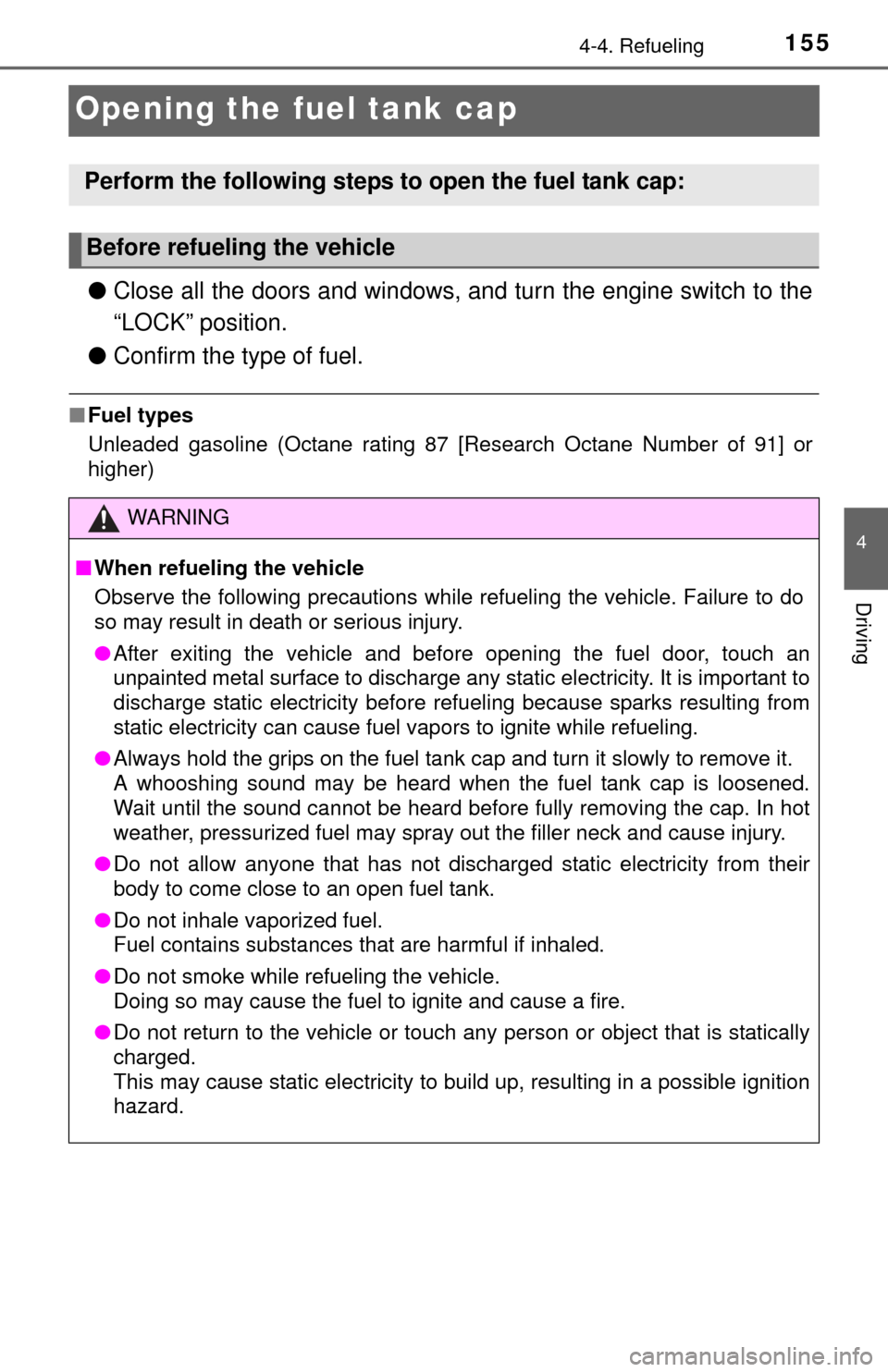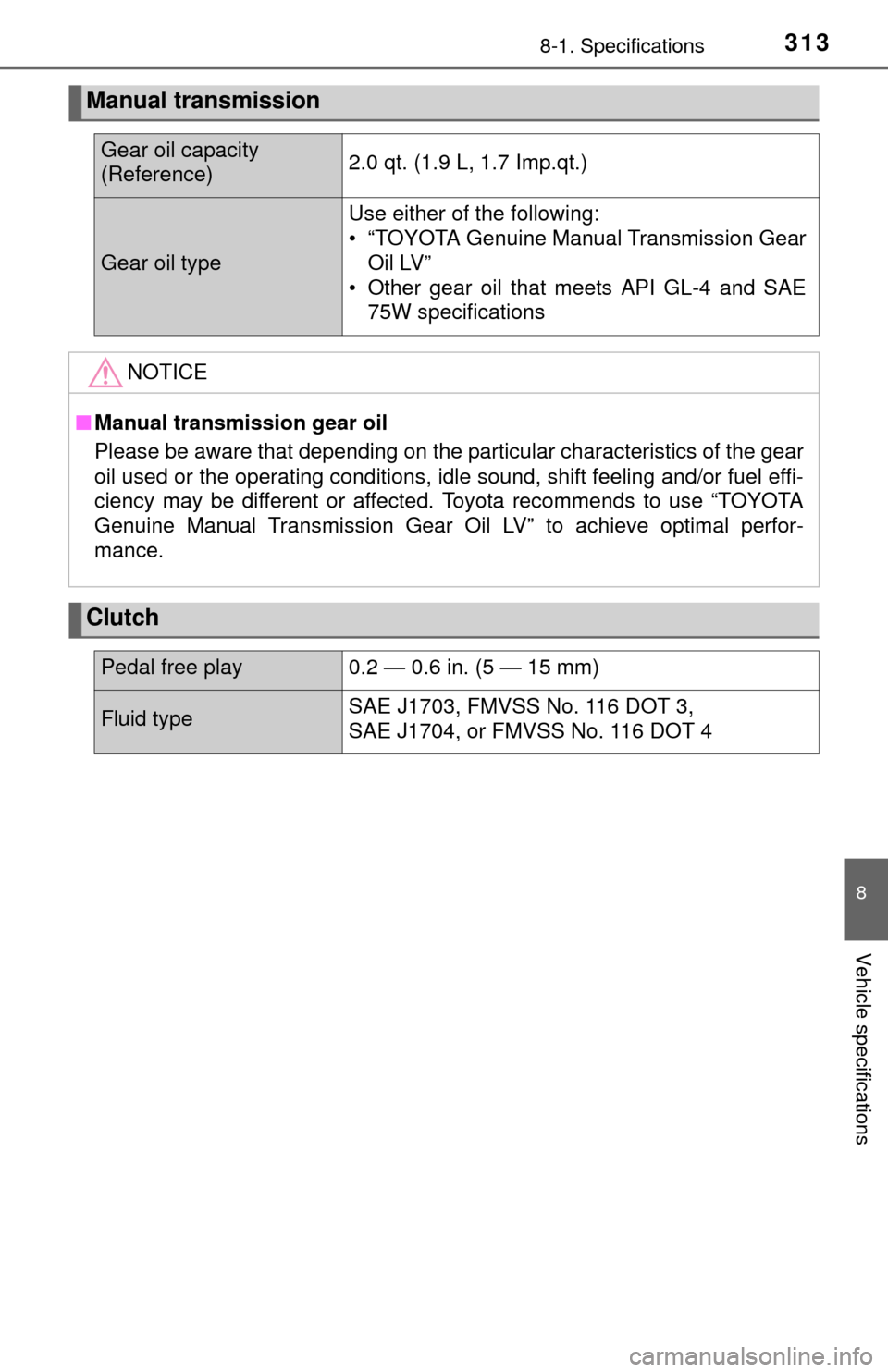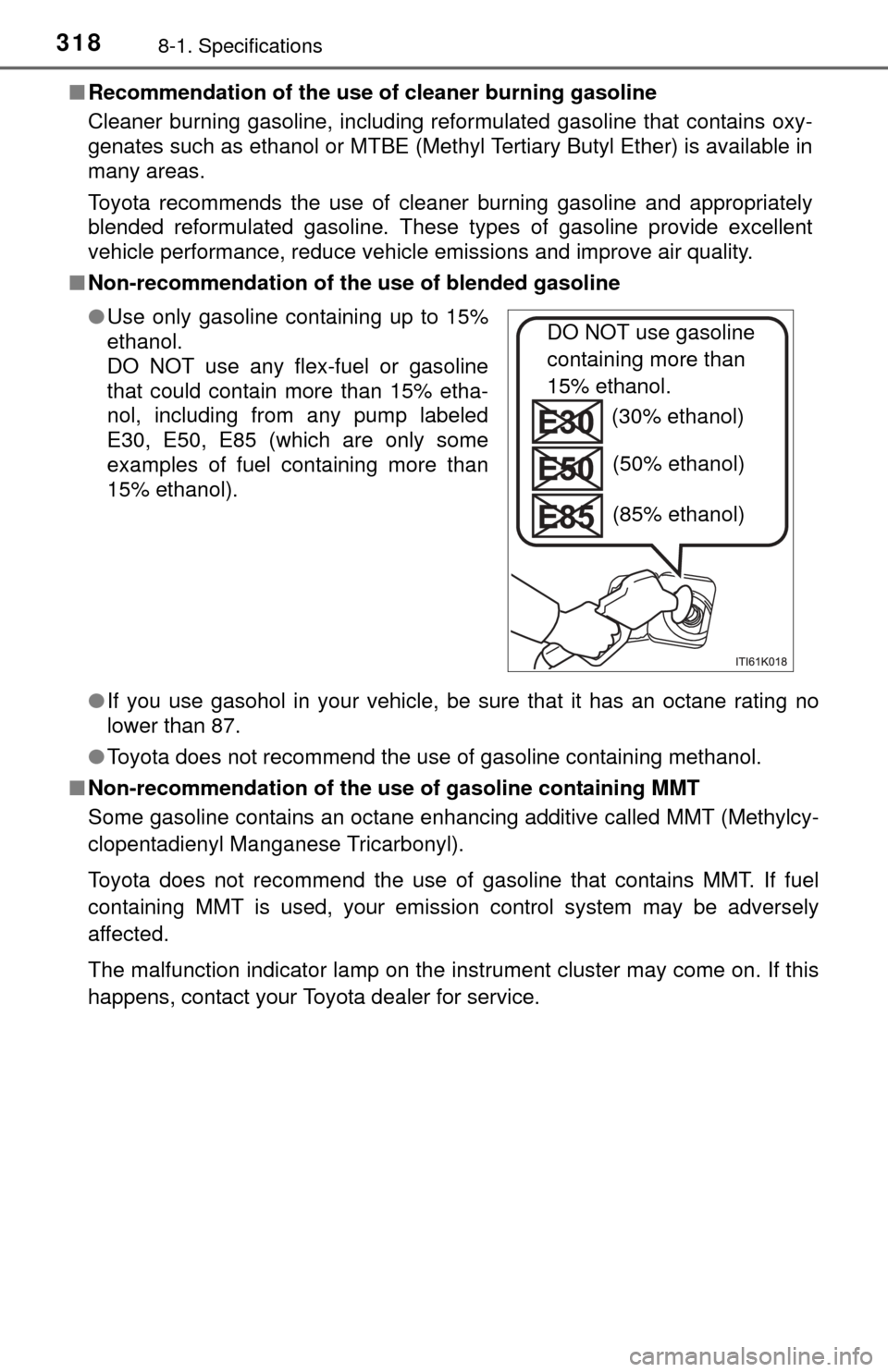2015 TOYOTA YARIS fuel type
[x] Cancel search: fuel typePage 13 of 364

13Pictorial index
Wipers . . . . . . . . . . . . . . . . . . . . . . . . . . . . . . . . . . . . . . . P. 149, 152
Precautions against winter season . . . . . . . . . . . . . . . . . . . . . P. 167
Fuel filler door . . . . . . . . . . . . . . . . . . . . . . . . . . . . . . . . . . . . P. 155
Refueling method . . . . . . . . . . . . . . . . . . . . . . . . . . . . . . . . . . . P. 155
Fuel type/fuel tank capacity . . . . . . . . . . . . . . . . . . . . . . . . . . . P. 310
Tires . . . . . . . . . . . . . . . . . . . . . . . . . . . . . . . . . . . . . . . . . . . . P. 223
Tire size/inflation pressure . . . . . . . . . . . . . . . . . . . . . . . . . . . . P. 315
Winter tires/tire chain . . . . . . . . . . . . . . . . . . . . . . . . . . . . . . . . P. 168
Checking/rotation . . . . . . . . . . . . . . . . . . . . . . . . . . . . . . . . . . . P. 223
Coping with flat tires . . . . . . . . . . . . . . . . . . . . . . . . . . . . . . . . P. 281
Hood . . . . . . . . . . . . . . . . . . . . . . . . . . . . . . . . . . . . . . . . . . . . P. 209
Opening . . . . . . . . . . . . . . . . . . . . . . . . . . . . . . . . . . . . . . . . . . P. 209
Engine oil . . . . . . . . . . . . . . . . . . . . . . . . . . . . . . . . . . . . . . . . . P. 310
Coping with overheat . . . . . . . . . . . . . . . . . . . . . . . . . . . . . . . . P. 300
Headlights/daytime running lights . . . . . . . . . . . . . . . . . . . . P. 144
Fog lights
* . . . . . . . . . . . . . . . . . . . . . . . . . . . . . . . . . . . . . . . P. 147
Turn signal lights . . . . . . . . . . . . . . . . . . . . . . . . . . . . . . . . . . P. 142
Stop/tail lights . . . . . . . . . . . . . . . . . . . . . . . . . . . . . . . . . . . . P. 144
License plate lights . . . . . . . . . . . . . . . . . . . . . . . . . . . . . . . . P. 144
Back-up lights
Shifting the shift lever to R . . . . . . . . . . . . . . . . . . . . . . . . P. 139, 141
4
5
6
7
Light bulbs of the exterior lights for driving
(Replacing method: P. 248, Watts: P. 316)
*: If equipped
8
9
10
11
12
13
Page 146 of 364

1464-3. Operating the lights and wipers
With the headlights on, push
the lever away from you to turn
on the high beams.
Pull the lever toward you to the
center position to turn the high
beams off.
Pull the lever toward you and
release it to flash the high
beams once.
You can flash the high beams with the headlights on or off.
■Daytime running light system (if equipped)
●Vehicles with reflector type headlights: To make your vehicle more visible to
other drivers, the headlights turn on automatically (at a reduced intensity)
whenever the engine is started and the parking brake is released. Daytime
running lights are not designed for use at night.
For type C of this headlight, daytime running lights can be turned off by
operating the switch.
Vehicles with projector type headlights: To make your vehicle more visible to
other drivers, the daytime running lights turn on automatically whenever the
engine is started and the parking brake is released. Daytime running lights
are not designed for use at night.
For type C of this headlight, daytime running lights can be turned off by
operating the switch.
● Compared to turning on the headlights, the daytime running light system
offers greater durability and consumes less electricity, so it can help improve
fuel economy.
■ Light reminder buzzer
A buzzer sounds when the engine switch is turned to the “LOCK” or “ACC”
position and the driver’s door is opened while the lights are turned on.
Turning on the high beam headlights
1
2
NOTICE
■To prevent battery discharge
Do not leave the lights on longer than necessary when the engine is not
running.
Page 155 of 364

1554-4. Refueling
4
Driving
Opening the fuel tank cap
●Close all the doors and windows, and turn the engine switch to the
“LOCK” position.
● Confirm the type of fuel.
■Fuel types
Unleaded gasoline (Octane rating 87 [Research Octane Number of 91] or
higher)
Perform the following steps to open the fuel tank cap:
Before refueling the vehicle
WARNING
■When refueling the vehicle
Observe the following precautions while refueling the vehicle. Failure to do
so may result in death or serious injury.
● After exiting the vehicle and before opening the fuel door, touch an
unpainted metal surface to discharge any static electricity. It is important to
discharge static electricity before refueling because sparks resulting from
static electricity can cause fuel vapors to ignite while refueling.
● Always hold the grips on the fuel tank cap and turn it slowly to remove it.
A whooshing sound may be heard when the fuel tank cap is loosened.
Wait until the sound cannot be heard before fully removing the cap. In hot
weather, pressurized fuel may spray out the filler neck and cause injury.
● Do not allow anyone that has not discharged static electricity from their
body to come close to an open fuel tank.
● Do not inhale vaporized fuel.
Fuel contains substances that are harmful if inhaled.
● Do not smoke while refueling the vehicle.
Doing so may cause the fuel to ignite and cause a fire.
● Do not return to the vehicle or touch any person or object that is statically
charged.
This may cause static electricity to build up, resulting in a possible ignition
hazard.
Page 310 of 364

3108-1. Specifications
*: The engine oil capacity is a reference quantity to be used when changingthe engine oil. Warm up and turn off the engine, wait more than 5 minutes,
and check the oil level on the dipstick.
■
Engine oil selection
“Toyota Genuine Motor Oil” is used in your Toyota vehicle. Use
Toyota approved “Toyota Genuine Motor Oil” or equivalent to satisfy
the following grade and viscosity.
Oil grade: ILSAC GF-5 multigrade engine oil
Recommended viscosity: SAE 5W-30
SAE 5W-30 is the best choice
for good fuel economy and
good starting in cold weather.
If SAE 5W-30 is not available,
SAE 10W-30 oil may be used.
However, it should be replaced
with SAE 5W-30 at the next oil
change.
Fuel
Fuel typeUnleaded gasoline only
Octane rating87 (Research Octane Number 91) or higher
Fuel tank capacity
(Reference)11.1 gal. (42 L, 9.2 lmp.gal.)
Lubrication system
Oil capacity
(Drain and refill
-reference
*)
With filter
Without filter 3.9 qt. (3.7 L, 3.3 Imp.qt.)
3.6 qt. (3.4 L, 3.0 Imp.qt.)
Outside temperature
Page 313 of 364

3138-1. Specifications
8
Vehicle specifications
Manual transmission
Gear oil capacity
(Reference)2.0 qt. (1.9 L, 1.7 Imp.qt.)
Gear oil type
Use either of the following:
• “TOYOTA Genuine Manual Transmission GearOil LV”
• Other gear oil that meets API GL-4 and SAE 75W specifications
NOTICE
■Manual transmission gear oil
Please be aware that depending on the particular characteristics of the gear
oil used or the operating conditions, idle sound, shift feeling and/or fuel effi-
ciency may be different or affected. Toyota recommends to use “TOYOTA
Genuine Manual Transmission Gear Oil LV” to achieve optimal perfor-
mance.
Clutch
Pedal free play0.2 — 0.6 in. (5 — 15 mm)
Fluid typeSAE J1703, FMVSS No. 116 DOT 3,
SAE J1704, or FMVSS No. 116 DOT 4
Page 318 of 364

3188-1. Specifications
■Recommendation of the use of cleaner burning gasoline
Cleaner burning gasoline, including reformulated gasoline that contains oxy-
genates such as ethanol or MTBE (Methyl Tertiary Butyl Ether) is available in
many areas.
Toyota recommends the use of cleaner burning gasoline and appropriately
blended reformulated gasoline. These types of gasoline provide excellent
vehicle performance, reduce vehicle emissions and improve air quality.
■ Non-recommendation of the use of blended gasoline
●If you use gasohol in your vehicle, be sure that it has an octane rating no
lower than 87.
● Toyota does not recommend the use of gasoline containing methanol.
■ Non-recommendation of the use of gasoline containing MMT
Some gasoline contains an octane enhancing additive called MMT (Methylcy-
clopentadienyl Manganese Tricarbonyl).
Toyota does not recommend the use of gasoline that contains MMT. If fuel
containing MMT is used, your emission control system may be adversely
affected.
The malfunction indicator lamp on the instrument cluster may come on. If this
happens, contact your Toyota dealer for service. ●Use only gasoline containing up to 15%
ethanol.
DO NOT use any flex-fuel or gasoline
that could contain more than 15% etha-
nol, including from any pump labeled
E30, E50, E85 (which are only some
examples of fuel containing more than
15% ethanol).
DO NOT use gasoline
containing more than
15% ethanol.
(30% ethanol)
(50% ethanol)
(85% ethanol)
Page 319 of 364

3198-1. Specifications
8
Vehicle specifications
■If your engine knocks
●Consult your Toyota dealer.
● You may occasionally notice light knocking for a short time while accelerat-
ing or driving uphill. This is normal and there is no need for concern.
NOTICE
■Notice on fuel quality
● Do not use improper fuels. If improper fuels are used, the engine will be
damaged.
● Do not use leaded gasoline.
Leaded gasoline can cause damage to your vehicle’s three-way catalytic
converters causing the emission control system to malfunction.
● Do not use gasohol other than the type previously stated.
Other gasohol may cause fuel system damage or vehicle performance
problems.
● Using unleaded gasoline with an octane number or rating lower than the
level previously stated will cause persistent heavy knocking.
At worst, this will lead to engine damage.
■ Fuel-related poor driveability
If poor driveability is encountered after using a different type of fuel (poor
hot starting, vaporization, engine knocking, etc.), discontinue the use of that
type of fuel.
■ When refueling with gasohol
Take care not to spill gasohol. It can damage your vehicle’s paint.
Page 358 of 364

358Alphabetical index
Flat tire...................................... 281
Floor mats .................................. 22
FluidAutomatic transmission......... 312
Brake .................................... 314
Clutch................................... 313
Washer ................................. 221
Fog lights ................................. 147 Replacing light bulbs............. 251
Switch ................................... 147
Wattage ................................ 316
Front passenger’s seat belt reminder light......... 274
Front seats ................................. 98 Adjustment .............................. 98
Cleaning................................ 197
Correct driving posture ........... 24
Head restraints ..................... 104
Front side marker lights.......... 144
Light switch ........................... 144
Replacing light bulbs............. 253
Wattage ................................ 316
Front turn signal lights ........... 142 Replacing light bulbs............. 254
Turn signal lever ................... 142
Wattage ................................ 316
Fuel Capacity ................................ 310
Fuel gauge .............................. 76
Fuel pump shut off system.... 271
Information ............................ 317
Refueling............................... 155
Type .............................. 155, 310
Warning light ......................... 274 Fuel consumption
Average fuel consumption ...... 80
Instantaneous fuel consumption ......................... 80
Fuel filler door ......................... 155 Refueling .............................. 155
Fuel pump shut off system..... 271
Fuses ........................................ 243
Gas station information .......... 364
Gauges ....................................... 76
Glove box ................................. 185
Hazard lights
Switch ................................... 262
Head restraints ........................ 104
Headlights ................................ 144 Light switch ........................... 144
Replacing light bulbs ............ 249
Wattage ................................ 316
Heaters ..................................... 172 Manual air conditioning system .......... ...................... 172
Outside rear view mirrors ..... 176
High mounted stoplight Replacing light bulbs ............ 258
Hood ......................................... 209 Open ..................................... 209
Hooks
Retaining hooks (floor mat) .... 22
Horn .......................................... 107
F
G
H